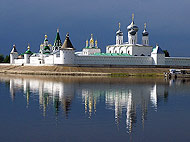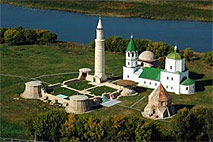The cruise starts in Nizhny Novgorod, goes down the Volga river to Kazan, then up the Kama river to the town of Yelabuga and then returns back to Nizhny Novgorod. This route could be a unique occasion for many participants to get familiar with Russian history, culture and nature of that region.
|
| |
 Nizhny Novgorod Nizhny Novgorod is the center of the Volga region. The third largest city in Russia, it was founded in 1221 at the confluence of two big rivers: the Volga and the Oka. Nizhny Novgorod was famous for its trade fairs, which attracted people from all parts of the country as well as from Europe and from the East. The Kremlin on the high bank of the Volga river is of special interest. There are many unique historical, architectural and cultural monuments preserved in Nizhny Novgorod and its vicinities. |
 Makaryev Convent was founded by the missionary Saint Macarius in the early 15th century.
Although, the Convent was burned by Tatar Khan Ulu Mukhammed in 1439, the monks rebuilt it later in stone; most of the existing major monastery buildings were constructed between 1651 and 1667. The view of the white towers of the Convent from the Volga river is really exciting. The famous Makaryev Fair took place every summer for more than two centuries outside of the walls of the Convent. This was one of the most famous and important merchant fairs in Eastern Europe. In 1817 the fair was moved to, where it became even more famous. Makaryev Convent was founded by the missionary Saint Macarius in the early 15th century.
Although, the Convent was burned by Tatar Khan Ulu Mukhammed in 1439, the monks rebuilt it later in stone; most of the existing major monastery buildings were constructed between 1651 and 1667. The view of the white towers of the Convent from the Volga river is really exciting. The famous Makaryev Fair took place every summer for more than two centuries outside of the walls of the Convent. This was one of the most famous and important merchant fairs in Eastern Europe. In 1817 the fair was moved to, where it became even more famous.
|
 Kazan Kazan is one of the oldest Tatar cities in Russia. The estimates of the date of its oundation range from the early 11th century to the late 13th century. It was the seat of the Tatar Khanate and the capital of a part of the Golden Horde in the 15th and 16th centuries. Now Kazan is famous for the unique blend of Muslim and Christian influences, magnificent ancient cathedrals and mosques, its beautiful Kremlin, and the Kul Sharif mosque built in 2005 to commemorate the millenium of the city. Kazan is the capital city of the Tatar Republic, where Tatar culture, language and traditions are thoroughly preserved. |
 Yelabuga Yelabuga is a beautiful city on the Kama river, whose history dates back to the 10th century when Volga Bulgarian border castle was built here. The 10th century tower and the ruins of a fortress on a picturesque hill make a magnificent view. The city center preserves the atmosphere of the XIX century. Yelabuga is the birthplace of Russian painter Ivan Shishkin, famous for his woodland sceneries. |
 Simbirsk was founded in 1648 by boyar Bogdan Khitrovo. The fort of "Simbirsk" was strategically placed on a hill on the Western bank of the Volga River. The fort was meant to protect the eastern frontier of the Russian Empire from the nomadic tribes and to establish a permanent Imperial presence in the area. In 1668, Simbirsk withstood a month-long siege by a 20,000-strong army led by rebel commander Stepan Razin. Later, in next century another famous country rebel, Yemelyan Pugachev, was imprisoned in Simbirsk before execution. In 18th century Simbirsk began to develop into an important regional center. The beautiful Holy Trinity Cathedral was constructed in a restrained Neoclassical style between 1827–1841. In 1924, the city was renamed Ulyanovsk in honor of Vladimir Ulyanov, better known as Lenin, who was born in Simbirsk in 1870. During the Soviet period, Ulyanovsk was an important tourist center, drawing visitors from around the country because of its revolutionary importance. Now the city attracts tourists mostly as an old russian town with its provincial beauty. |
 The town is situated on the left bank of the Volga river at a 200 km distance from Kazan, near the ancient city of Bolgar founded here in IX-X centuries. Volga Bulgars became muslim in 922, accepting new religion from Bagdad Caliphate. Information about this northern muslim state appeared then in Arabian and Persian historical literature of the Middle Ages. Volga Bulgars interacted as well with neighbor Slavonic countries - Kiev Russia and North-East principalities of the Upper Volga. However, when in 1236 the Golden Horde started the conquest of the Eastern Europe, Russians were enslaved and Volga Bulgaria lost much of its independent state and became one of the most famous parts of the Golden Horde. In the 14th century Bulgaria started to decline. The city of Bolgar was abandoned and since the end of the XVIII century only a small village was situated nearby. Only in 1957 a new town was founded which got the name Bolgar in 1991. The ancient city of Bolgar is now a historical and architecture museum. |